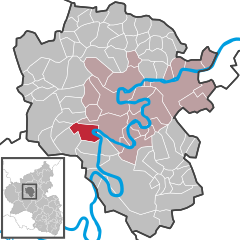Bremm
Possibly in the early centuries of the Christian era, either a small settlement or a great homestead lay there.
While cultivating the land in the 1950s, winegrowers reported problems that arose during ploughing due to foundation walls in the ground.
The lovely Baroque altar from 1630 was sold to Schloss Gondorf at the time of the remodelling, but in 1968 it was bought back for DM 30,000.
The municipality's arms might in English heraldic language be described thus: Tierced in mantle, dexter sable three ogival windows in fess under which a fess wavy Or, sinister argent a cross patriarchal gules, in base vert a bunch of grapes slipped of the second.
The charge on the dexter (armsbearer's right, viewer's left) side refers to the picturesque ruin across the Moselle from the village, on the right bank.
Boundary stones marking the convent's former vineyards, landholdings and woodlands still bear this symbol.
The bunch of grapes, of course, refers to the municipality's main economic structure, which is winegrowing.
The following are listed buildings or sites in Rhineland-Palatinate’s Directory of Cultural Monuments: As early as 2,000 years ago, the Romans, having recognized the advantages of the slaty soil on the steep slopes facing the sun, planted here in the Bremmer Calmont the first grapevines.
Grown here are most outstanding Riesling wines, which at both state and federal levels achieve high awards.




